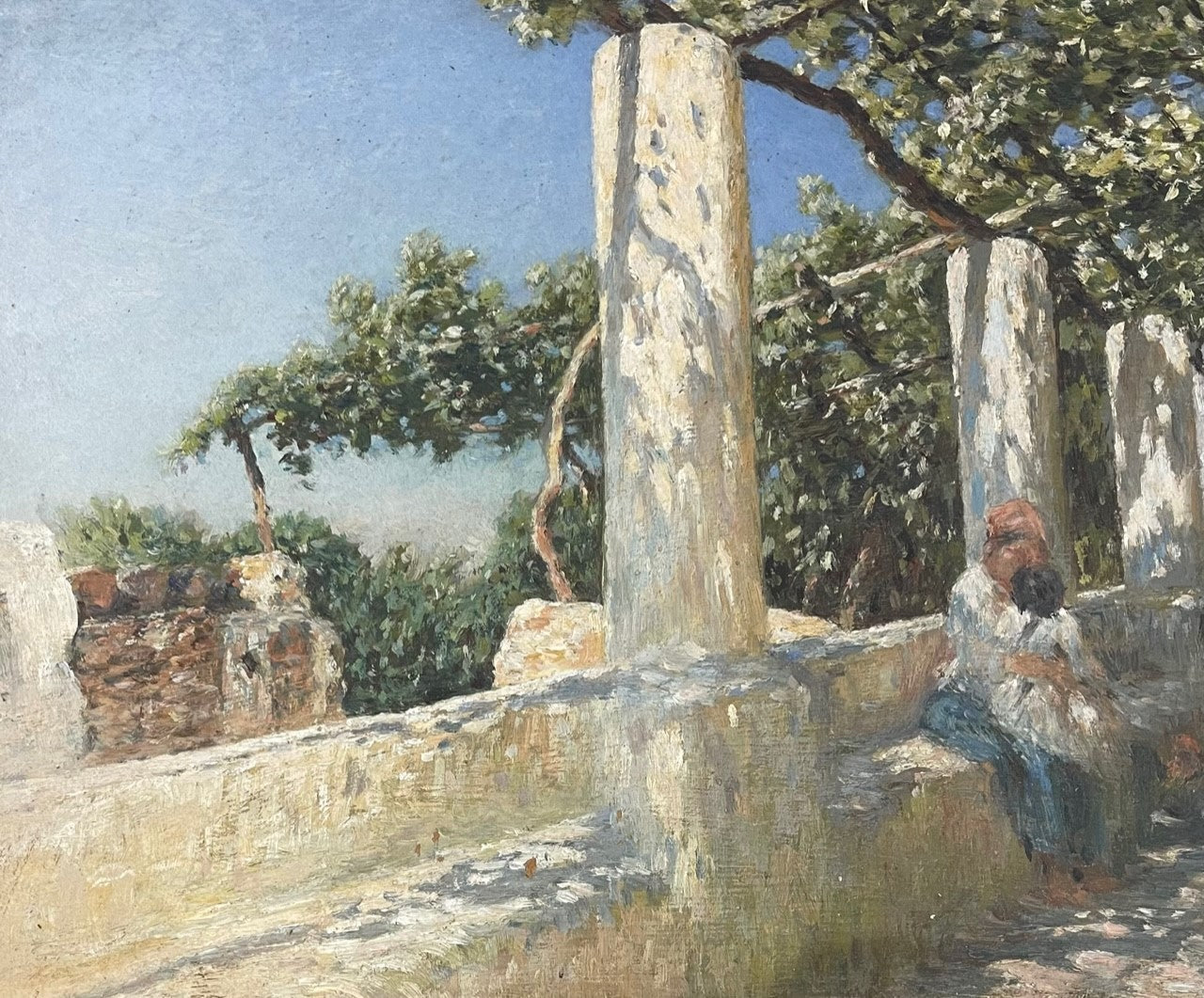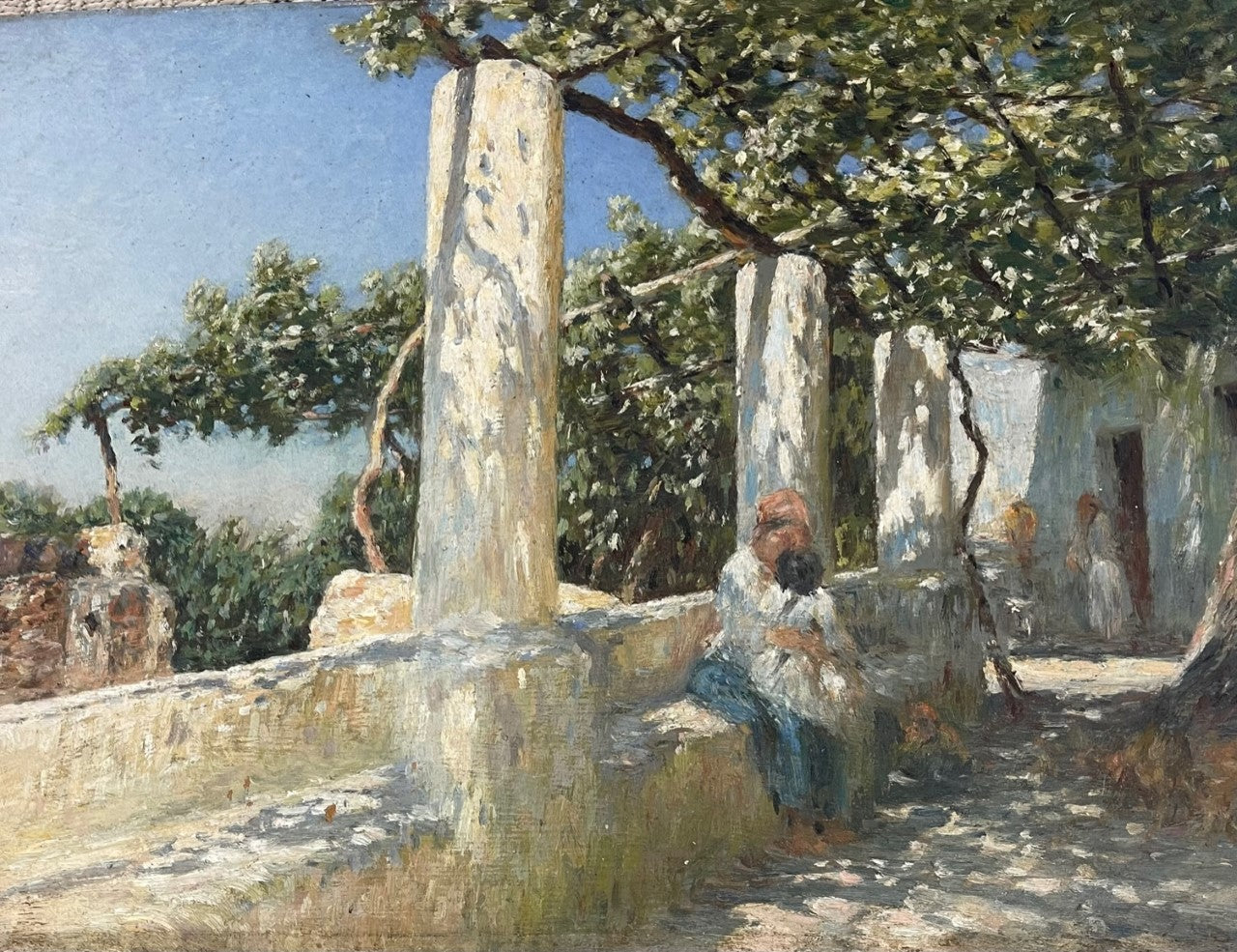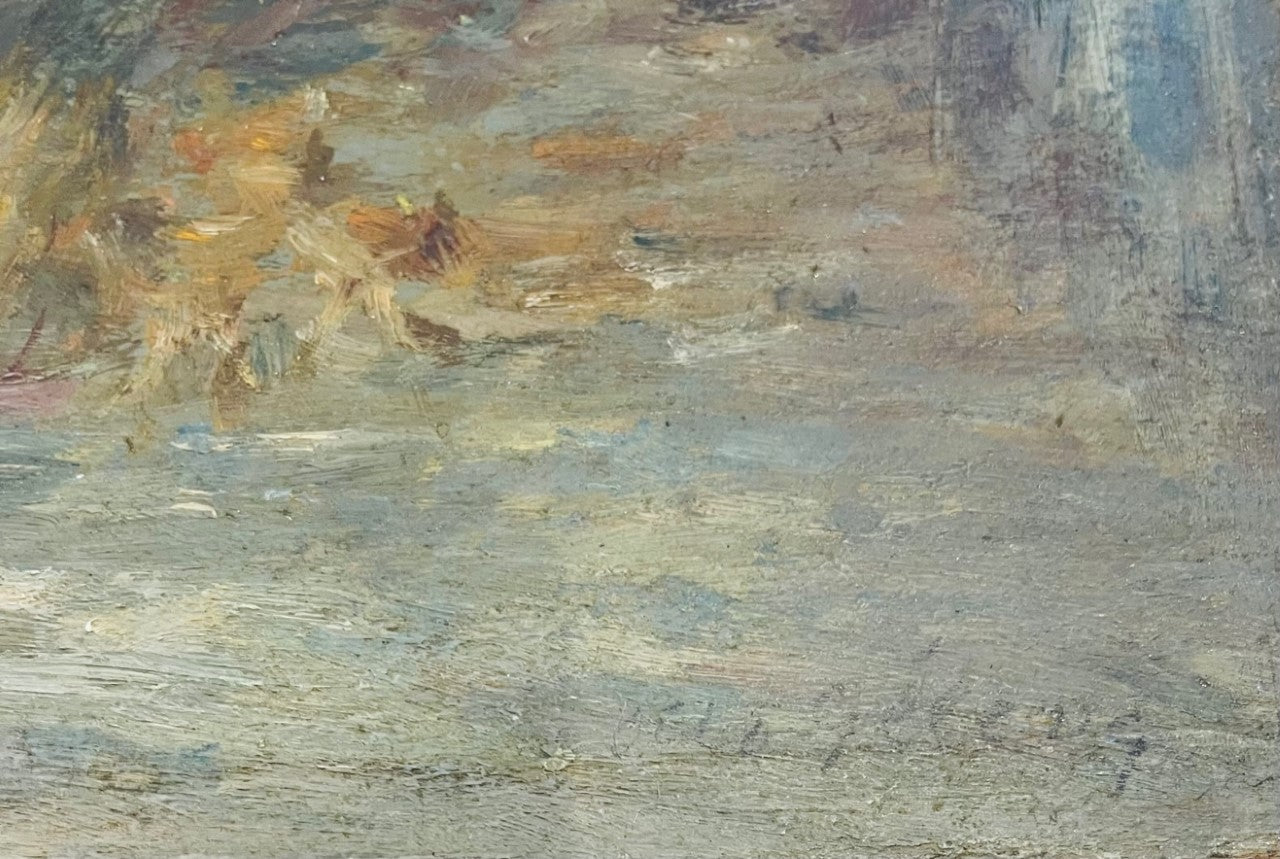A View From An Italian terrace
Regular price
£1,500.00 GBP
Regular price
Sale price
£1,500.00 GBP
Unit price
per
Tax included.
Couldn't load pickup availability
A view from an Italian terrace
Otto Frederich Geleng 1843 – 1939
Size 40 x 64cm
Italian Impressionist Oil on board signed at bottom right.
Otto Geleng studied at the prestigious “Real Academy of Berlin”, under the supervision of noted professor Biermann, a man very familiar with Sicily as he had visited many times and had produced enchanting views, reproducing the landscapes of Selinunte, Segesta and Siracusa.
Seeing them, Geleng, was so enraptured that he decided to leave at once for Italy. His first stop was in Rome, where he arrived in 1861, becoming partner of the Circolo Artistico del Principe Poli and making friends with the composer Liszt and with Count Zeppelin, inventor of famous airships. In Rome he received a visit from King Federico of Prussia, on honeymoon with Victoria of England.
In 1862 he decided to continue his Italian tour and left at once for Naples, Amalfi and Capri, before arriving in February of 1863, in Taormina, where he stayed in the modest house of Francesco La Floresta.
At the end of the that year he left for Rome by train, continuing his journey towards the north to meet professor Biermann in Berlin. However, the young painter wouldn’t stay away too long from Taormina, where he would return the following year.
After having shown his Taormina paintings in many circles and prestigious art exhibitions all around Europe, many artists were impressed by the picturesque landscapes with almond trees in bloom surrounded by the snow capped peaks of Etna, thinking that they were no more than figments of the Geleng’s imagination.
And so the Prussian painter invited them to see the countryside of Taormina for themselves, he organised a trip to Taormina with some artist friends who refused to believe that such a picturesque place could really exist. Once again he stayed with Francesco La Floresta who pushed by Geleng, gave the place the name “Timeo”, like the son of Andromaco, founder and tyrant of Taormina in the IV century BC.
In 1874, Francesco La Floresta celebrated the nucleus of what would become the glorious Grand Hotel Timeo, adapting his house to meet the growing needs of international tourism and opening a new season and new page in the history of tourism and hospitality in Taormina.
In Taormina, the young painter earned his fame along with the great consideration of his contemporaries. Having married a beautiful girl from Taormina, Filomena Zuccaro, he decided to live in Taormina, where he opened his atelier on the Corso Umberto (today number 190), where after his daughter Angelina would live, wife of the Baron Giuseppe Paternò Castello of Biscari, descendent of Principe Ignazio V, collectionist, patron of the arts and first Inspector of antiquities in Sicily. Still today if you look at the front of the Geleng’s house, you can recognise between the balconies of the first floor the ancient coat of arms of the Paternò Castello family.
In 1872, people of the town proposed that Geleng should become deputy mayor of Taormina, a responsibility that he would uphold for ten years.
During his travels through Europe and thanks to his own works, he continued to make propaganda of Taormina as a custodian of beauty and a place enchanted with history and art.
Not surprisingly the National Exhibition of Palermo called him to exhibit his paintings of Taormina and he was named “corresponding Fellow” of the Academy of Zelanti, of the Dafnici of Acireale and an honorary member of the Association of Fine Arts.
During the war, he was confined in a prison of war camp in Bronte because he was a citizen of the enemy. For Geleng, who had done so much for Taormina, it was a humiliation that would be difficult to forget. Freed from the prison in 1919, he returned to Taormina where he died in 1939.
Otto Frederich Geleng 1843 – 1939
Size 40 x 64cm
Italian Impressionist Oil on board signed at bottom right.
Otto Geleng studied at the prestigious “Real Academy of Berlin”, under the supervision of noted professor Biermann, a man very familiar with Sicily as he had visited many times and had produced enchanting views, reproducing the landscapes of Selinunte, Segesta and Siracusa.
Seeing them, Geleng, was so enraptured that he decided to leave at once for Italy. His first stop was in Rome, where he arrived in 1861, becoming partner of the Circolo Artistico del Principe Poli and making friends with the composer Liszt and with Count Zeppelin, inventor of famous airships. In Rome he received a visit from King Federico of Prussia, on honeymoon with Victoria of England.
In 1862 he decided to continue his Italian tour and left at once for Naples, Amalfi and Capri, before arriving in February of 1863, in Taormina, where he stayed in the modest house of Francesco La Floresta.
At the end of the that year he left for Rome by train, continuing his journey towards the north to meet professor Biermann in Berlin. However, the young painter wouldn’t stay away too long from Taormina, where he would return the following year.
After having shown his Taormina paintings in many circles and prestigious art exhibitions all around Europe, many artists were impressed by the picturesque landscapes with almond trees in bloom surrounded by the snow capped peaks of Etna, thinking that they were no more than figments of the Geleng’s imagination.
And so the Prussian painter invited them to see the countryside of Taormina for themselves, he organised a trip to Taormina with some artist friends who refused to believe that such a picturesque place could really exist. Once again he stayed with Francesco La Floresta who pushed by Geleng, gave the place the name “Timeo”, like the son of Andromaco, founder and tyrant of Taormina in the IV century BC.
In 1874, Francesco La Floresta celebrated the nucleus of what would become the glorious Grand Hotel Timeo, adapting his house to meet the growing needs of international tourism and opening a new season and new page in the history of tourism and hospitality in Taormina.
In Taormina, the young painter earned his fame along with the great consideration of his contemporaries. Having married a beautiful girl from Taormina, Filomena Zuccaro, he decided to live in Taormina, where he opened his atelier on the Corso Umberto (today number 190), where after his daughter Angelina would live, wife of the Baron Giuseppe Paternò Castello of Biscari, descendent of Principe Ignazio V, collectionist, patron of the arts and first Inspector of antiquities in Sicily. Still today if you look at the front of the Geleng’s house, you can recognise between the balconies of the first floor the ancient coat of arms of the Paternò Castello family.
In 1872, people of the town proposed that Geleng should become deputy mayor of Taormina, a responsibility that he would uphold for ten years.
During his travels through Europe and thanks to his own works, he continued to make propaganda of Taormina as a custodian of beauty and a place enchanted with history and art.
Not surprisingly the National Exhibition of Palermo called him to exhibit his paintings of Taormina and he was named “corresponding Fellow” of the Academy of Zelanti, of the Dafnici of Acireale and an honorary member of the Association of Fine Arts.
During the war, he was confined in a prison of war camp in Bronte because he was a citizen of the enemy. For Geleng, who had done so much for Taormina, it was a humiliation that would be difficult to forget. Freed from the prison in 1919, he returned to Taormina where he died in 1939.








